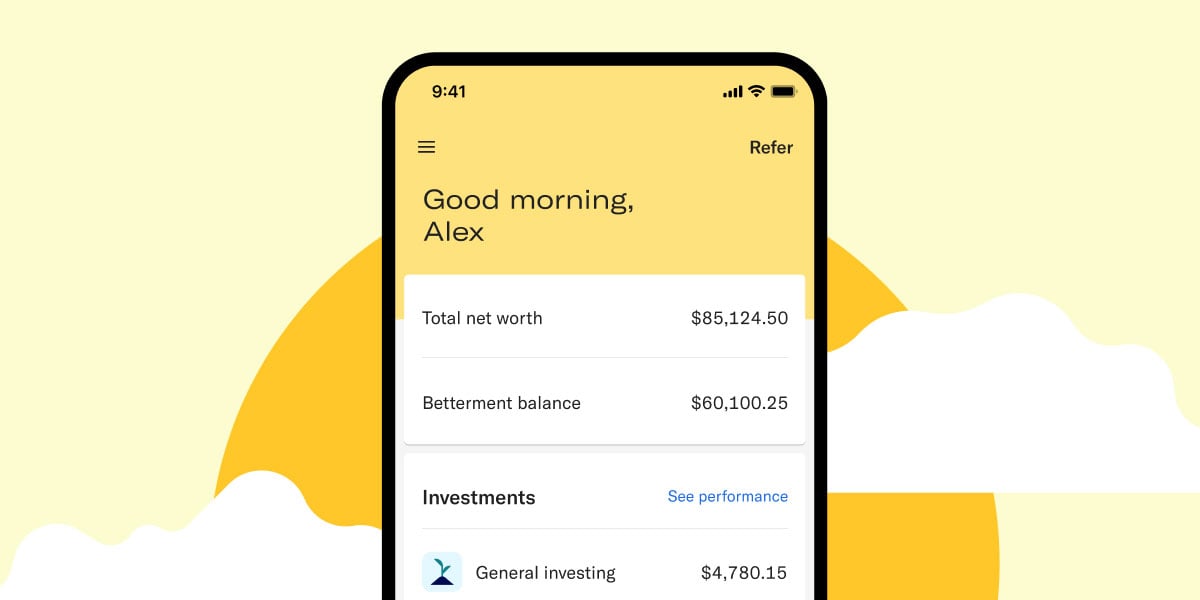Funds And Investments

Featured articles
-
![]()
Betterment’s 401(k) Investment Approach
Helping employees make better decisions and providing choice to those who want it.
Betterment’s 401(k) Investment Approach Helping employees make better decisions and providing choice to those who want it. Dan Egan, Betterment’s VP of Behavioral Finance and Investing, explains why Betterment’s investment approach is effective for all 401(k) participants Investment Approach Q&A Betterment’s 401(k) investment approach differs from that of traditional providers, but can you give us a little history about the 401(k) environment pre-Betterment? If I go back to the first job where I had a 401(k) probably about 20 years ago, there was a lineup of funds, and it was up to me as a 401(k) participant to figure out which funds to pick and in what ratios, how much to save and so on. The research coming from that period showed that people often ended up in an analysis paralysis state, where there was so much choice and so many things to consider. It was very difficult for people to know whether they were investing at the appropriate risk level, how much they were paying and so on. Many people were so overloaded that they decided to forego saving for retirement rather than risk making a “bad” decision. But as the industry matured, and everyone realized that more choice does not necessarily lead to better decision-making, the Pension Protection Act (PPA) was passed in 2006. The idea here was not to eliminate choice, but to encourage good defaults that would encourage 401(k) plan participation. How exactly did the PPA encourage more 401(k) participation? For one thing, it allowed for safe harbor investments in the form of QDIAs, or qualified default investment alternatives. The most popular QDIAs were target date funds, which are linked to an individual’s age so if you're 40, it’s assumed that you will be investing for the next 25 years and retiring at 65. Target dates have a glidepath so that the stock allocation becomes more conservative over time, so the employee doesn't have to do anything like managing a portfolio or rebalancing. After the PPA, it became much more common for employees to be auto-enrolled using a target date fund or something like it, and all of sudden, they no longer had to make choices. People were no longer worried about picking and choosing from a whole bunch of individual funds or even individual stocks. And the plan designs promoted by the PPA really worked: plan participation rates that had been languishing saw rates increase to more than 90% after implementing auto-enrollment. By the time Betterment started its 401(k) platform, the changes brought about by the PPA were already well established. So talk a little bit now about how Betterment's 401(k) investment approach differs from that of traditional 401(k) providers. Betterment takes and builds upon a lot of the ideas in a target date fund and goes further. Number one, we are not a fund provider. We are independent from fund companies. So part of our job as a 3(38) investment fiduciary is to be an investment advisor and financial advisor, and do the due diligence on all of the funds that we make available. If you're picking from amongst eight large-cap US stock funds, there's not a lot of variation in what their returns are going to look like and you can generally predict performance versus a benchmark knowing the fund costs. So part of our job is to actually do the work on the behalf of participants, to narrow down the field of funds towards just the ones that stand out within a given asset class and that are cost-effective. We then ask more specific questions including not just how old someone is, but also more personalized questions like when someone plans on retiring. Some people want to retire as early as possible. That might be 55, 57, 62 (which is the earliest possible age you can start collecting Social Security). Other people want to keep working as late as possible, which is 70 or 72. Those are extremely different retirement plans that should have different portfolios based upon those hugely different time horizons. So unlike a target date fund, which says, this is your age and you're done, Betterment is going to ask about your age, but also things like, when do you want to retire? Putting together a retirement plan might also involve your spouse or significant others, retirement assets, and even doing tax optimization across the account types that you have available to you. And how does that help the employee? A lot of it is about making it easy for consumers to make better decisions, not imposing a bunch of choices on them. You have to remember, the vast majority of people are not frequently thinking about stocks and investing. They don't want to have to look up prospectuses and put together a risk managed portfolio. So Betterment does the work for them to make it easy for them to understand how to get to where they want to be. I want to be clear that that's not necessarily about removing choice, it's about making it easy to get to a solution quickly. It’s also about minimizing the number of unnecessary choices for most people while maintaining choice for people who want it. At Betterment, 401(k) investors can still modify your risk level. You can say, "Yeah, maybe it makes sense for me to be at 90% stocks, but I'm not comfortable with it. I want to be at 30% stocks." Or they can modify their allocations using our flexible portfolio strategy, so that they can come in and say, "Actually I don't like international [investments] as much." So it's not about removing choice. And we let them see the consequences of that in terms of risk and return. So employees in Betterment 401(k)s have choice, but how do you respond to people who might already have a 401(k) or are already invested in funds outside of their 401(k), and have a favorite fund that they feel is an absolute must have? I’m not necessarily against people who have put time and effort into researching something and wanting to invest in it. But I think it is focusing on the wrong thing. When you look at long-run research statistics on funds, the predictability of fund success within a category is low. A fund that outperformed last quarter is unlikely to continue to outperform this quarter. So I would say that the fund is very rarely the most important aspect of the 401(k) plan or decision. And I’d guess most participants don't have a favorite fund. Again, going back to research we've looked at across a wide array of companies, most people are looking to minimize how much burden is imposed upon them in making decisions about what they should do for their retirement. There is generally a very small minority who have very strong views about what the right investments are. And that trade-off shows up in that we will generally look at low-cost funds, well-diversified funds. We do offer a range of choice in terms of portfolio strategy: do you want a factor-tilted portfolio or a socially-responsible portfolio or an income portfolio? Without necessarily saying that you're responsible for doing the fund due diligence yourself. It is true that we offer a trade-off: we're not the wild west where you can go out and get anything you want. And that is because that level of discretion is rarely used by plan participants. There's a lot of potential to do the wrong thing when somebody has a completely open access plan. Not to mention, all plan fiduciaries have an obligation to act in the best interests of their plan participants as a whole. So they have to evaluate what makes the most sense for the majority of plan participants, not a small, vocal minority. Somewhat related, what is your response to people who argue that Betterment’s all-ETF fund line-up is too limited? A 401(k) plan made up exclusively of ETFs is no less limiting than a 401(k) plan made up exclusively of mutual funds. Because mutual funds have been around much longer, it’s true that their universe is larger, but I think anyone would be hard pressed to argue that our expert-built and third-party portfolios are not enough to choose from. ETFs are critical to Betterment’s investment approach and a better alternative for 401(k) plans, in large part because mutual funds have complex fee structures and are typically more expensive than ETFs which have transparent and low costs. So why do so many plans still use mutual funds? We believe it’s not despite these issues but because of them, since fees embedded in mutual fund expense ratios are often used to offset the costs of 401(k) vendors servicing the plan. In addition, many legacy recordkeeping systems do not have the technology to handle ETF intraday trading and must restrict their clients to using funds that are only valued at the end of the day. Betterment’s 401(k) plan comes with a 0.25% investment advisory fee. What do employers and employees get for that? I think there's actually two levels to this. The first is “does this actually cost me more?” It’s definitely more transparent in its cost, but most 401(k) plans charge more via higher fund fees. The fund fees may even include embedded fees that go to pay for other plan services. In these more traditional models, the fees are hidden from you, the consumer. But trust me: everybody is getting paid. It's just a matter of whether or not you're aware how much and who you're paying. That also sets up the very important second aspect which is: what is this investment manager responsible for and what are they incentivized to do well? What does Betterment do for 25 basis points? Well, number one, that's how we make sure that we're independent from the fund companies; we don’t get paid by them. Every quarter, we go out and we look at all of the funds that are available in the market. We review them, independent of who provides them, looking at cost, liquidity, tax burdens, and more. And if we find a better fund, because we take no money from fund companies, we're going to move to that better fund. So one thing that you're paying for is, in effect, not only ongoing due diligence and checking, but you're paying for independence, which means that you know we’re unbiased when changes are made inside of your portfolio. The other thing you get is that we want to earn that 25 basis points by serving clients better. So we want to invest in things like personalized retirement portfolios (available to every 401(k) participant) where we are actually able to give better retirement advice that takes into account you, your partner, all the various kinds of retirement accounts you have: Roth, IRA, taxable, trust, and more. Or asset location, for example, which works across tax-advantaged retirement accounts so that employees can keep more of their money and enjoy higher levels of spending in retirement. Employees with a Betterment 401(k) can learn more about our investment options here; plan sponsors can explore them here. -
![]()
ETFs and managed portfolios as options in your 401(k) Plan
At Betterment, we use exchange-traded funds (ETFs) to build our managed portfolios. Learn ...
ETFs and managed portfolios as options in your 401(k) Plan At Betterment, we use exchange-traded funds (ETFs) to build our managed portfolios. Learn about the different types of investment vehicles and how Betterment crafts our investment solutions. Mutual funds have historically dominated the retirement investment landscape. Over time, exchange-traded funds (ETFs) have received more attention due to their cost-effectiveness and flexibility. Here at Betterment, we use them to build our diversified managed ETF portfolios. Learn about the differences between the investment vehicles and the ways investments can be managed. What is active vs. passive (Indexing) investing? People often associate active or passive investing with certain investment vehicles (e.g. ETFs or mutual funds). However, active and passive are really two different management strategies. Characteristics Active Passive (indexing approach) Portfolio managers/team use their investment expertise in an attempt to outperform their benchmark or specified market index. x Portfolio managers/team seeks to match the performance of their benchmark, usually a market index such as the S&P 500. x Usually has relatively high turnover (meaning they will buy/sell securities more frequently) x Usually has low turnover x Tends to have higher management fees x Tends to have lower management fees x Higher tracking error (Greater volatility in returns as they deviate from the index to drive outperformance) x Lower tracking error (Lower volatility in returns as they try to replicate the index they are tracking and invest in the same securities) x Exchange-traded funds are: x x Mutual funds are: x x From the table above, notice how both ETFs AND mutual funds can be actively or passively managed. What’s the difference between mutual funds and ETFs? ETFs and mutual funds do have qualities in common. Both consist of a mix of many different assets, which helps investors easily diversify their portfolios. However, they have a few key differences: Mutual Funds ETFs Both Most are actively managed Tend to have higher fees, sales charges Less transparent, holdings typically disclosed monthly or quarterly Trades once per day, bought and sold directly with the mutual fund provider Mutual funds still remain the dominant investments in 401(k) plans Most are passively managed, but can be active Relatively lower fees Have clear goals and mandates Transparent Liquid, trades throughout the day (like a stock) ETFs are growing quickly Unique product structure with creation/redemption mechanism Easy diversification Easily access a variety of exposures, eg. stocks, bonds, commodities, alternatives, themes, etc. Costs have reduced over time Mutual funds are traditionally known for their active approach. It is a key reason why mutual funds tend to have higher fees and higher expense ratios than ETFs. Costs are also higher in instances where smaller retirement plans do not have access to institutional share classes. However, Index mutual funds, which are passively managed and lower in costs, have continued to become more popular. ETFs, on the other hand, are usually passively managed. More differentiated ETFs however, that are actively managed or use other fundamentals like factors (smart beta), have emerged over the years. Most ETFs are transparent, meaning you can see the underlying holdings daily. Mutual funds either report their holdings monthly or quarterly. ETFs can be traded like stocks whereas mutual funds may only be purchased at the end of each trading day based on a calculated price. ETFs have a unique share creation and redemption mechanism, which provides efficiencies such as reducing trade costs incurred by the fund, allowing tighter tracking to the index. Differences in costs between mutual funds and ETFs Another difference to highlight is costs. Both mutual funds and ETFs have some form of implicit and explicit costs. Here’s a breakdown of the different types: Types of Costs Mutual Funds ETFs Management fee Both include a stated management fee Trading costs N/A May trade at a price slightly more or less than NAV Transaction costs May include sales loads, redemption fees Similar to stocks, may be subject to brokerage commissions Revenue sharing agreements Agreements among 401(k) plan providers and mutual fund companies include: 12(b)-1 fees, which are disclosed in a fund’s expense ratios and are annual distribution or marketing fees Sub Transfer Agent (Sub-TA) fees for maintaining records of a mutual fund’s shareholders Revenue sharing agreements often appear as conflicts of interests. Soft-dollar arrangements These commission arrangements, sometimes called excess commissions, exacerbate the problem of hidden expenses because the mutual fund manager engages a broker-dealer to do more than just execute trades for the fund. These services could include nearly anything—securities research, hardware, or even an accounting firm’s conference hotel costs. These are the different types of costs that can ultimately drive the “all-in” mutual funds fees experience to be different from ETFs. What else didn’t I realize about mutual funds? Conflicts of interest Often, there are conflicts of interest with mutual funds. Some service providers are, at their core, mutual fund companies. And therefore, some investment advisors are incentivized to promote certain funds. This means that the fund family providing 401(k) services and the advisor who sells the plans may have a conflict of interest. Some mutual funds invest in a portfolio of ETFs Target-date funds have evolved to now include ETFs, so it is important to understand the way your TDFs are constructed and that ETFs are also being considered for a traditional mutual fund product like TDFs. Why is it unusual to see ETFs in 401(k)s? The 401(k) market is largely dominated by players who are incentivized to offer certain mutual funds. Plans are often sold through distribution partners, which can include brokers, advisors, recordkeepers or third-party administrators. The fees embedded in mutual funds help offset expenses and facilitate payment of every party involved in the sale. However, it’s challenging for employers and employees because the fees aren’t easy to understand even with the mandated disclosure requirements. Existing technology limitations prevent traditional recordkeeping systems from supporting ETFs. Most 401(k) recordkeeping systems were built decades ago and designed to handle once-per-day trading, not intra-day trading (the way ETFs are traded)—so these systems can’t handle ETFs on the platform (at all). How Betterment manages your investments Betterment combines managed ETF portfolios with personalized, unbiased advice to create an easy solution for today’s retirement savers. At Betterment, we use ETFs as the building blocks for our managed portfolios where you have the ability to choose from a menu of portfolio strategies that are managed over time. To select the ETFs that we use to construct our portfolios, we use our proprietary unbiased investment selection methodology that is based on qualitative and quantitative factors, always serving your employees’ best interest. Many retirement plans use target-date funds because they are often viewed as a one-stop solution. While having specific retirement date funds (2045 Fund, 2050 Fund, etc.) may satisfy most investors, it is important to consider options for those whose circumstances have changed (if someone decides to retire early, for example) and require flexibility. Betterment can tailor our advice to the exact year your employees want to retire. Our retirement advice adapts to your employees’ desired retirement timeline and can be customized for their risk appetite if they want to be more conservative or aggressive. Betterment can also tell your employees if they‘re on or off track, factoring in all of their retirement savings, Social Security, pensions, and more. Employees can also link outside investments, savings accounts, IRAs—even spousal/partner assets—to create a real-time holistic snapshot of their finances. It can make saving for retirement (and any other short- or long-term goals) even easier. At Betterment, we believe in providing investment options and retirement advice that allows for customization and flexibility in a cost-effective way. Interested in bringing a Betterment 401(k) to your organization? Get in touch today at 401k@betterment.com. -
![]()
Crypto in 401(k) Plans: The Department of Labor’s Guidance
The US Department of Labor (DOL) released fresh guidance on cryptocurrency investments for ...
Crypto in 401(k) Plans: The Department of Labor’s Guidance The US Department of Labor (DOL) released fresh guidance on cryptocurrency investments for fiduciaries of retirement plans. This article describes the DOL’s guidance and its implications for retirement plans. The US Department of Labor (DOL) issued on March 10th what can be considered a warning to retirement plan fiduciaries that already or will in the future provide cryptocurrency options for 401(k) plan participants. In the wake of President Biden signing an executive order that directs the federal government to develop plans for regulating cryptocurrencies (and digital assets), the DOL published Compliance Assistance Release No. 2022-01, a note that details its perspective on crypto investments and hints that the department’s Employee Benefits Security Administration will conduct investigations of plans that currently offer crypto and related investment options. This article will describe the DOL’s guidance and its implications for retirement plans. What does the DOL note say? The release issued by the DOL primarily serves as a heads up of some of the concerning aspects of crypto investing that should be very carefully considered by plan fiduciaries in order to avoid a breach of their duty to “act solely in the financial interests of plan participants and adhere to an exacting standard of professional care.” The release does not explicitly forbid crypto and related investment options within 401(k)s but instead lists risks associated with such investments. It also conveys that fiduciaries must be able to answer how they “square” providing crypto, if offered, with their fiduciary duties in the context of these risks. The specific risks the DOL identifies are shown below. Risk Description Speculative and Volatile Investments The DOL warns that many crypto investments are subject to extreme volatility, exhibiting sharp swings higher and lower, with the potential that a large drawdown could significantly impair a plan participant’s retirement savings. The Challenge for Plan Participants to Make Informed Investment Decisions The DOL notes that difficulties exist for unsophisticated investors to “separate the facts from the hype” and make informed decisions when it comes to crypto, especially when compared with more traditional investments Custodial and Recordkeeping Concerns The vulnerabilities of much of the current crypto investment infrastructure to hacks and theft is a specific concern to the DOL given the severity of a plan participant losing the entirety of their crypto position Valuation Concerns The difficulty of determining a fundamental value of crypto investments compared to traditional asset classes, along with differences in accounting treatment and reporting among crypto market intermediaries, make up additional concerns to the DOL Evolving Regulatory Environment According to the DOL, “fiduciaries who are considering whether to include a cryptocurrency investment option will have to include in their analysis how regulatory requirements may apply to issuance, investments, trading, or other activities and how those regulatory requirements might affect investments by participants in 401(k) plans” What does this mean for Betterment at Work? 401(k) plans accessed through the Betterment at Work platform currently do not offer crypto investment options. As a 3(38) investment fiduciary, Betterment reviews investments on an ongoing basis to ensure we’ve performed our due diligence in selecting investments suitable for participants' desired investing objectives. As crypto markets and the regulatory environment around retirement plans evolve, Betterment will re-evaluate the suitability of crypto investments within retirement accounts. We will continue to monitor ongoing developments and keep you informed, similar to our efforts to track the DOL’s guidance for Environmental, Social, and Governance-related investing within retirement plans. The above material and content should not be considered to be a recommendation. Investing in digital assets is highly speculative and volatile, and only suitable for investors who are able to bear the risk of potential loss and experience sharp drawdowns. Digital assets are not legal tender and are not backed by the U.S. government. Digital assets are not subject to FDIC insurance or SIPC protections.




